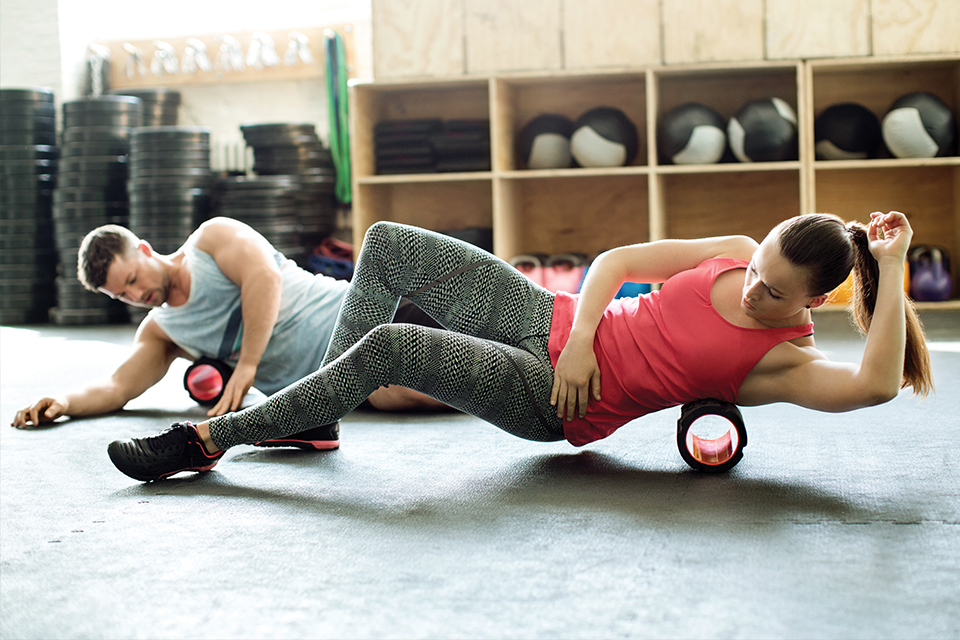The Top 5 Ways to Recover from Your Workouts Faster

You wake up feeling strong, supple, and motivated to build the body you want or to dominate training for your next race or competition. You rack up your cardio minutes, hammer through your resistance training, and you feel invincible…until you get up the next day.
You’re probably feeling Delayed Onset Muscle Soreness (DOMS), which is the muscle tenderness, stiffness, and pain that occurs several hours—or even days—after strenuous exercise. In addition to the dreaded DOMS (an important but painful aspect of overall health, shape, and performance), we may feel some other not-so-nice side effects; hence, the need for swift recovery. Here are the top five ways to recover from your workouts faster, so you can get back to feeling like your best, fittest self.
Branched Chain Amino Acids (BCAAs)
Amino acids are the building blocks of protein and the end product of protein digestion. Branched Chain Amino Acids, or BCAAs are a combination of three of those protein (and muscle!) builders: valine, leucine and iso-leucine. According to Starkie Sowers, a faculty researcher at the Huntington College of Health Sciences, supplementation with BCAAs is used for exercise recovery and the reduction of protein loss in the muscles. She states it is estimated that between three and 18 percent of all exercise energy is used by BCAAs—sometimes even more, depending on the duration and intensity of the workout. Considering how much our workout energy relies on BCAAs, it is important to replenish our stores.
BCAAs may be taken before, during, and after workouts. A quick source to your bloodstream is in powder or pill form, but BCAAs are also found in household foods like: whey and milk proteins, animal protein, eggs, almonds, cashews, pumpkins seeds, chickpeas, lentils, and corn.
Glutamine
Glutamine is the most abundant amino acid in the body. During times of stress like when you’re ill, injured, or heavily exercising, your glutamine levels become depleted in response to rising cortisol levels, according to literature from the University of Maryland Medical Center. Cortisol is a hormone that causes your muscle tissue to break down, which is the last thing you need when prepping for your next tournament or gym session. Luckily, consuming glutamine after exercising has been found to boost your immune system—helping you to fight off infections, reduce muscular fatigue, and get back in the gym or out on the trails faster.
Even better, the immune recovery benefits of glutamine span outside workout recovery. According to recent studies, glutamine has been also used successfully to assist with recovery in patients who have HIV/AIDS, severe burns, cancer, irritable bowel syndrome, and other diseases. Glutamine may be taken anytime, but is typically ingested post-workout.
Like BCAAs, glutamine may be taken in powder or pill form. Foodies will enjoy the following exceptional options, including: plant and animal proteins such as beef, pork, poultry, milk, yogurt, ricotta cheese, cottage cheese, raw spinach, raw parsley, and cabbage.
Foam Rolling
Foam rolling is a myofascial technique in which you place yourself on a cylindrical, foamed surface to exert pressure on your body’s soft tissue.
Sweeping the foam roll back and forth beneath your body while applying pressure stretches and relieves tension in the muscle tissues and fascia. It is essentially a self-message. Per a study published in the Journal of Athletic Training, foam rolling is found to be “relatively affordable, easy to perform, time efficient and enhances muscle recovery.” More specifically, the study claims that DOMS was drastically reduced after a 20-minute bout of foam rolling and continuing the myofascial release every 24 hours thereafter.
Foam rolling sessions not only reduce muscle soreness—they actually improve overall athletic ability.
If you want to see better results from your workouts and more pain-free mornings, add foam rolling to your daily regimen.
Get Your Zs
Lack of sleep is detrimental to our bodily recovery. In fact, studies by the Gatorade Sports Science Institute show that your cognitive performance, mood, appetite regulation, metabolism, and immune function all suffer from poor sleep habits. Skimping on sleep also stunts your muscle recovery. If you’re struggling to get more than six hours of shut-eye a night, all is not lost: research shows that taking naps is beneficial as well. Find ways to hit the sheets an hour or two earlier each night or sprinkle in an afternoon nap when you can—your muscles and mind will thank you.
Yoga
Yoga in its physical form is a series of physical postures, deep breathing, and meditation techniques that has enormous benefits to improve athletic recovery. From the International Journal of Physical Education, Health and Sports: “Although most poses are non-aerobic in nature, the physical postures send oxygen to the cells in the body by way of conscious deep breathing and sustained stretching and contraction of different muscle groups.”
Yoga also strengthens deep connective tissues, preventing or minimizing injury and pain. You might even notice you have more endurance since yoga makes your cardiovascular and respiratory systems work more efficiently. In addition, yoga improves your circulatory system by massaging internal organs and glands with your breath and postures. And if that weren't enough, it also improves your sleep!
Try any of these tips after your next workout session and get ready for less hours of “ouch” and more time achieving your health and fitness goals.






